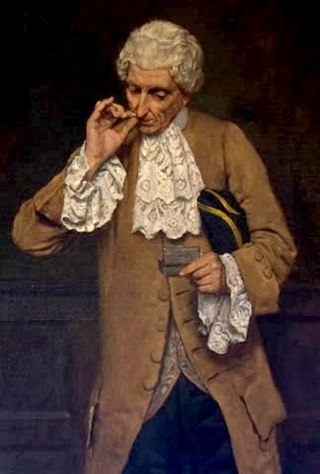
Tobacco is the common name of several plants in the genus Nicotiana of the family Solanaceae, and the general term for any product prepared from the cured leaves of these plants. More than 70 species of tobacco are known, but the chief commercial crop is N. tabacum. The more potent variant N. rustica is also used in some countries.

Tobacco smoking is the practice of burning tobacco and ingesting the resulting smoke. The smoke may be inhaled, as is done with cigarettes, or simply released from the mouth, as is generally done with pipes and cigars. The practice is believed to have begun as early as 5000–3000 BC in Mesoamerica and South America. Tobacco was introduced to Eurasia in the late 17th century by European colonists, where it followed common trade routes. The practice encountered criticism from its first import into the Western world onwards but embedded itself in certain strata of a number of societies before becoming widespread upon the introduction of automated cigarette-rolling apparatus.

Snus is a tobacco product, originating from a variant of dry snuff in early 18th-century Sweden. It is placed between the upper lip and gum for extended periods, as a form of sublabial administration. Snus is not fermented. Although used similarly to American dipping tobacco, snus does not typically result in the need for spitting and, unlike naswar, snus is steam-pasteurized.

Chewing tobacco is a type of smokeless tobacco product that is placed between the cheek and lower gum to draw out its flavor. It consists of coarsely chopped aged tobacco that is flavored and often sweetened; it is not ground fine like dipping tobacco. Unwanted juices are then spat.
Dipping tobacco is a type of finely ground or shredded, moistened smokeless tobacco product. It is commonly and idiomatically known as "dip". Dipping tobacco is used by placing a pinch, or "dip", of tobacco between the lip and the gum. The act of using it is called dipping. Dip is colloquially called "chaw", "snuff", "rub", or "fresh leaf" among other terms; because of this, it is sometimes confused with other tobacco products—namely nasal/dry snuff.

Smokeless tobacco is a tobacco product that is used by means other than smoking. Their use involves chewing, sniffing, or placing the product between gum and the cheek or lip. Smokeless tobacco products are produced in various forms, such as chewing tobacco, snuff, snus, and dissolvable tobacco products. Smokeless tobacco products typically contain over 3000 constituents. All smokeless tobacco products contain nicotine and are therefore highly addictive. Quitting smokeless tobacco use is as challenging as smoking cessation.

A tobacconist, also called a tobacco shop, a tobacconist's shop or a smoke shop, is a retailer of tobacco products in various forms and the related accoutrements, such as pipes, lighters, matches, pipe cleaners, and pipe tampers. More specialized retailers might sell ashtrays, humidification devices, hygrometers, humidors, cigar cutters, and more. Books and magazines, especially ones related to tobacco are commonly offered. Items irrelevant to tobacco such as puzzles, games, figurines, hip flasks, walking sticks, and confectionery are sometimes sold.
Tobacco harm reduction (THR) is a public health strategy to lower the health risks to individuals and wider society associated with using tobacco products. It is an example of the concept of harm reduction, a strategy for dealing with the use of drugs. Tobacco smoking is widely acknowledged as a leading cause of illness and death, and reducing smoking is vital to public health.
Elbert D. Glover is an American researcher and author in the field of tobacco addiction and smoking cessation. After several academic positions, he retired as professor emeritus at the University of Maryland at College Park School of Public Health where he served as Chairperson of the Department of Behavioral and Community Health from 2005 to his retirement in 2015. Moreover, he was entrepreneur, editor, publisher, co-founder and principal owner of Health Behavior and Policy Review, and co-founder, owner, editor, and publisher of American Journal of Health Behavior and Tobacco Regulatory Science. Glover was the founder of the American Academy of Health Behavior and served as its first president from 1997 to 2001.

Tobacco was long used in the early Americas. The arrival of Spain introduced tobacco to the Europeans, and it became a lucrative, heavily traded commodity to support the popular habit of smoking. Following the Industrial Revolution, cigarettes became hugely popular worldwide. In the mid-20th century, medical research demonstrated severe negative health effects of tobacco smoking including lung and throat cancer, which led to a sharp decline in tobacco use.

The Family Smoking Prevention and Tobacco Control Act, is a federal statute in the United States that was signed into law by President Barack Obama on June 22, 2009. The Act gives the Food and Drug Administration the power to regulate the tobacco industry. A signature element of the law imposes new warnings and labels on tobacco packaging and their advertisements, with the goal of discouraging minors and young adults from smoking. The Act also bans flavored cigarettes, places limits on the advertising of tobacco products to minors and requires tobacco companies to seek FDA approval for new tobacco products.

Tobacco has a long history in the United States.

Regulation of tobacco by the U.S. Food and Drug Administration began in 2009 with the passage of the Family Smoking Prevention and Tobacco Control Act by the United States Congress. With this statute, the Food and Drug Administration (FDA) was given the ability to regulate tobacco products.
Tobacco usage in sport is a well documented and publicised occurrence. Tobacco advertising has connected itself to sports both for the connotations of health that sports provide, as well as the marketing potential of famous athletes. Additionally, tobacco has played a role in the sport of baseball specifically and has affected both the rules affecting players and fan alike. Agencies such as the CDC have used sports as platforms for tobacco prevention programs, specifically targeted at younger people.

Cigarette smoking for weight loss is a weight control method whereby one consumes tobacco, often in the form of cigarettes, to decrease one's appetite. The practice dates to early knowledge of nicotine as an appetite suppressant.

In Finland, the smoking figures are among the lowest in Europe. There are several factors that have influenced the decrease in the smoking prevalence, such as legislative actions, health promotion and national monitoring systems, policies aimed at reducing tobacco consumption through public awareness campaigns, advertising bans and increased taxation. Ministry of Social Affairs and Health has the leading role in tobacco control in Finland, and one of their main aims is have a more effective ban on sale of tobacco products to children and young people and to prevent sale of illegal tobacco products. Among the key elements in the successful tobacco policy is the traditional collaboration between the health authorities and non-governmental organisations, and intensive health promotion.
Tobacco is an agricultural product acting as a stimulant triggering complex biochemical and neurotransmitter disruptions. Its main ingredient is nicotine and it is present in all cigarettes. Early tobacco usage was for medical cures and religious purposes. In the early 1900s, cigarette usage became increasingly popular when it was sold in mass amounts. In 1964, the Surgeon General of the United States wrote a report concerning the dangers of cigarette smoking. In the United States, for the past 50 years efforts have been made so that the public should be aware of the risks of tobacco usage.
The University of California, San Francisco (UCSF) Truth Tobacco Industry Documents is a digital archive of tobacco industry documents, funded by Truth Initiative and created and maintained by the University of California, San Francisco. The Library is a part of the larger UCSF Industry Documents Library which also includes the Drug Industry Document Archive, the Food Industry Documents Archive and the Chemical Industry Documents Archive. TTID contains over 14 million documents produced by major tobacco companies and organizations, many of them internal strategic memoranda made public as a consequence of the Tobacco Master Settlement Agreement. The documents deal with the tobacco industry's advertising, manufacturing, marketing, sales, and scientific research activities for the last century. Researchers, journalists, students, and activists interested in tobacco control issues and public health policies use the Library extensively to investigate tobacco industry strategies. Research in this archive revealed the tobacco industry playbook and its parallels with techniques linked to climate change denial.

As nicotine is highly addictive, marketing nicotine-containing products is regulated in most jurisdictions. Regulations include bans and regulation of certain types of advertising, and requirements for counter-advertising of facts generally not included in ads. Regulation is circumvented using less-regulated media, such as Facebook, less-regulated nicotine delivery products, such as e-cigarettes, and less-regulated ad types, such as industry ads which claim to discourage nicotine addiction but seem, according to independent studies, to promote teen nicotine use.












